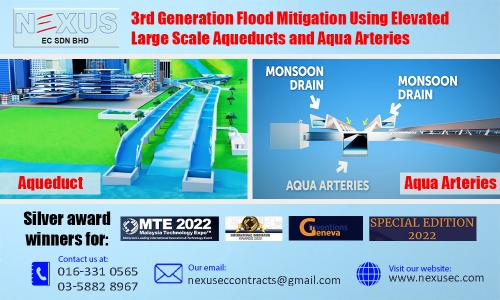3rd Generation Flood Mitigation uses Large Scale Aqueducts and Aqua Arteries to clear excess flood water
Heavy rainfall and flood events are not strange phenomena that we are required to deal with once in a while. These events are yearly re-occurrence event gauged as Average Recurrence Interval (ARI). ARI is statistical estimation of the average return period in years between the occurrence of a flood of a given magnitude. For instance, 1 in 100-year flood is expressed as 100 year ARI.
We have been living with the fact flood happens, as long as it is “not in my back yard”. The recent flood event in Klang Valley and Peninsular Malaysia have brought the flood water to everyone’s door step. It made everyone in the country to be directly and indirectly involved or effected by the flood event. We have seen for the first time the nation has come together to support the flood victims.
Gone are the days natural disasters are localized, due to global warming and climate change, the weather has gone from mild to extreme. The unprecedented event recorded 54 fatalities and two missing (Bernama News,2021) with massive social and economic losses.
In Selangor several areas such as Taman Sri Muda, Klang, Shah Alam, Banting, Hulu Langat and etc. where badly effected due to the torrential rainfall and flooding. In addition, geographically Klang, Shah Alam, Banting and etc. are all located at downstream which are flat terrain / low lying relative to the sea levels. This location has the characteristics of delta which are prone to flooding.
As for flood mitigation measures, it generally involve the construction of monsoon drains, flood walls, floodgates, river dykes or bunds, weirs, diversion culverts, tunnels or dams based on site suitability and the characteristics of river. Sometimes, rivers are dug deeper to increase the water holding and flow capacity.
The conventional methods can be classified as 1st and 2nd generation. The 1st generation mainly consist of river widening, deepening, strengthening, off river storage or detention ponds. Where else the 2nd generation flood mitigation was developed when the concrete and steel technology started to dominate the construction industry. The second generation of flood mitigation consist of deep detention ponds, underground diversion culverts or tunnels, weirs and etc.
Despite having the 1st and 2nd generation mechanism for flood mitigation, certain inland areas are still prone to flooding during wet and monsoon seasons, especially when downpours are heavy. This is because the existing 1st and 2nd generation flood mitigation component have limited storage or discharge capacity to mitigate excess rainwater or overflows along existing river. The existing components are also limited to invert levels and FINITE storage and discharge capacity. Hence additional water management structures that can hold water and divert large volumes of excess water directly to the sea are needed to address the flood issues in low lying areas, due to storm surge and sea water rise. The 3rd generation component are free of invert level limitation and have INFINITE discharge capacity, making it ideal to clear excess flood water effectively and reduce loss of lives and economy.
The 3rd-generation flood mitigation systems were developed with requirement to channel unlimited volume of excess flood water directly towards the sea by elevating the flood water above the high tide levels or storm surge levels before discharging to the sea. Aqueduct and Aqua Arteries acts as the third-generation flood mitigation mechanism where flood water will be transferred via an elevated channel and discharge directly to the sea. This system are not govern by change in sea water levels and global climate change. It will have long term performance capacity.
The aqueducts can also be used in combination of flood diversion tunnels, drains and multiple decks structure which can be used for water flow and as motorway, boating and recreational activities.
The innovation can also be integrated with aqua arteries (large underground monsoon drains installed to collect excess flood water from surface monsoon drains) which will deliver the flood water and flash floods to the aqueducts. The flood water from aqua arteries will be then pumped on the aqueducts, which will rapidly discharge the flood water to the sea, above high tide or storm surge. Aqua arteries can also be used as capacity enhancement for undersized or under capacity monsoon drains. The system can contribute to prevent flash floods effectively.
This 3rd-generation flood mitigation system with the various combination, especially with aqua arteries and plurality pumps, pumping flood waters onto aqueduct for direct discharge will assist in reducing potential loss of lives, properties and economy. This innovation has been patented.
The system will also act as reliable failure proof mechanism with INFINITE discharge to defend the low laying areas which are subject to flooding when the heavy rainfall occurs during sea or storm surge. Well managed and implemented 3rd generation flood mitigation system will contribute in saving lives and reducing the potential loss of the properties and economy of a country. The suffering of poor people who are victims of flood cause by global warming and rise in sea water levels can be eliminated or reduced significantly by using our innovation of 3rd generation flood mitigation works. The system can also be used to solve water shortages by supplying water, recharging ground water and also used for irrigation. Visit us for further details at http://www.nexusec.com or email us at [email protected]
RM12.50 / month
- Unlimited access to award-winning journalism
- Comment and share your opinions on all our articles
- Gift interesting stories to your friends
- Tax deductable
